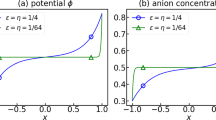Abstract
The determinationof electric potentials in finite regions of symmetrical electrolyte in one-dimensional equilibrium situations requires the solution of the one-dimensional Poisson-Boltzmann equation in which the dependent variable is linearly related to the electric potential and contains unknown parameters. These require evaluation as part of the solution to a given boundary value problem. The general solution of the equation is presented. This involves elliptic functions and integrals and is sectionally isomorphic with respect to an integration parameter. The application to problems posed in terms of both initial values and two-point boundary values is discussed. The solution is used to determine the potential and concentration distributions between two flat-faced charged particles immersed in an electrolyte liquid and having interacting double layers.
Similar content being viewed by others
Literature
Ciani, S., G. Eisenman and G. Szabo. 1969. “A Theory for the Effects of Neutral Carriers such as Macrotetralide Actin Antibiotics on the Electric Properties of Bilayer Membranes.”J. Membrane Biol. 1, 1–36.
Debye, P. and E. Huckel. 1923. “Zur Theorie der Elektrolyte.”Phys. Z. 24, 185–208.
Goldman, D. E. 1943. “Potential, Impedance and Rectification in Membranes.”J. gen. Physiol. 27, 37–60.
Kobatake, Y., Y. Toyoshima and N. Takeguchi. 1966. “Studies of Membrane Phenomena. II. Theoretical Study of Membrane Potentials.”J. phys. Chem., Wash. 70, 1187–1193.
Lauger, P. and B. Neumcke. 1973. “Theoretical Analysis of Ion Conductance in Lipid Bilayer Membranes.” InMembranes—A Series of Advances, Ed. G. Eisenman, Vol. 2. New York: Marcel Dekker.
Lev, A. A., V. V. Malev and V. V. Osipov. 1973. “Electrochemical Properties of Thick Membranes with Macrocyclic Antibodies.” InMembranes—A Series of Advances. Ed. G. Eisenman, Vol. 2. New York: Marcel Dekker.
Marshall, E. A. 1977. “The Osmotic Flow of an Electrolyte through a Charged Porous Membrane.”J. theor. Biol. 66, 107–135.
Marshall, E. A. 1982. “The Effect of Protein Charge on the Osmotic Pressure of Blood Plasma.” In preparation.
— and D. W. Windle. 1978. “Ion Transfer during Electrolyte Osmosis through a Charged Porous Membrane.”J. theor. Biol. 73, 383–425.
Milne-Thompson, L. M. 1950.Jacobian Elliptic Function Tables. New York: Dover Publications.
Mott, N. F. 1939. “The Theory of Crystal Rectifiers.”Proc. R. Soc. A171, 27–38.
Verwey, E. J. W. and K. F. Niessen. 1939. “The Electric Double Layer at the Interface of Two Liquids.”Phil. Mag. 28, 435.
— and J. Th. G. Overbeek. 1948.Theory of the Stability of Lyophobic Colloids. New York: Elsevier.
Author information
Authors and Affiliations
Rights and permissions
About this article
Cite this article
Marshall, E.A. Equilibrium electropotentials in electrolyte systems. Bltn Mathcal Biology 44, 669–687 (1982). https://doi.org/10.1007/BF02462275
Received:
Revised:
Issue Date:
DOI: https://doi.org/10.1007/BF02462275




